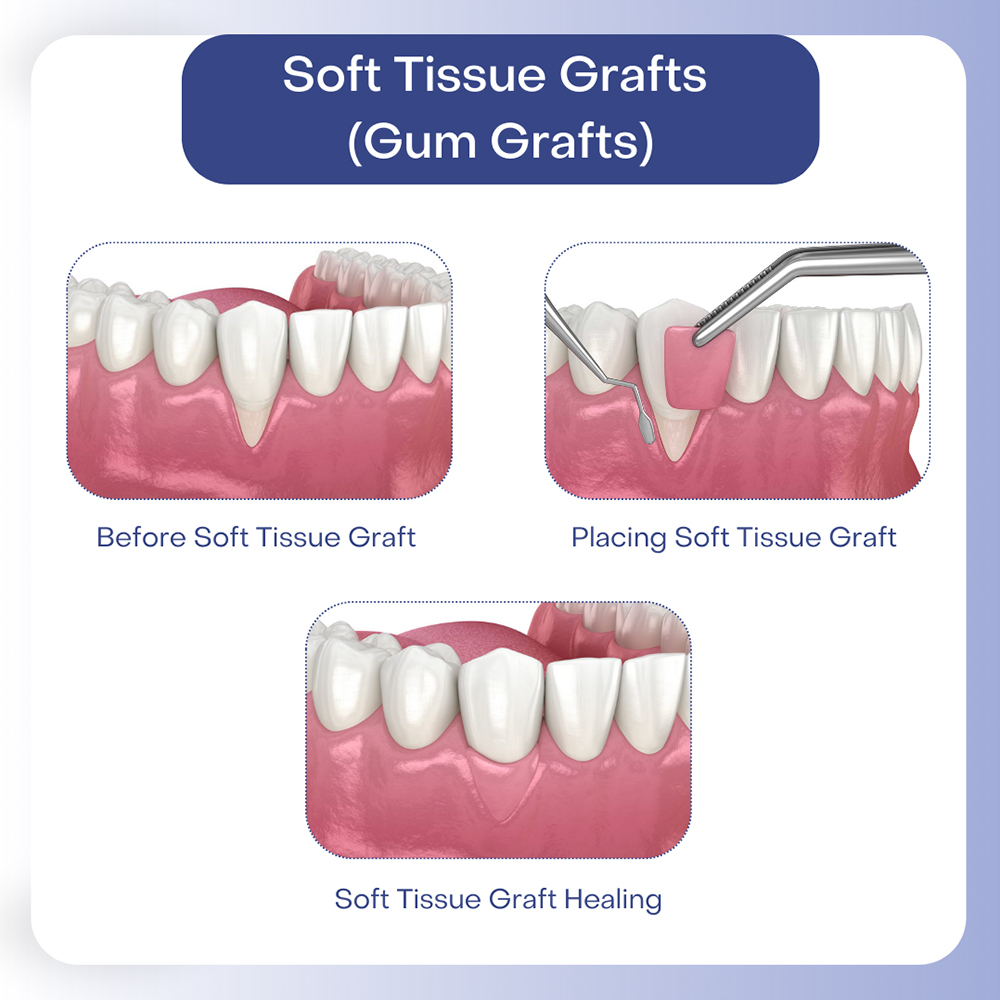Table of contents
If we recommend you have a gum graft, there is no need to worry. It is a straightforward procedure. Below, you’ll discover more about what to expect and the different types of gum grafts that can be used.
 Gum grafting treats problems with receding or thinning gums, where your gums have pulled away from your teeth, exposing your tooth roots so your teeth look longer. Exposed tooth roots can cause problems with sensitivity. The risk of decay is higher because they are not covered in protective tooth enamel.
Gum grafting treats problems with receding or thinning gums, where your gums have pulled away from your teeth, exposing your tooth roots so your teeth look longer. Exposed tooth roots can cause problems with sensitivity. The risk of decay is higher because they are not covered in protective tooth enamel.
A gum graft must usually be completed by a periodontist, who is a specialist dentist. The procedure restores lost tissue around your teeth, helping to make it easier to maintain good oral hygiene and healthy teeth and gums.
There are several reasons why we may suggest you have a gum graft. The most common is gum recession due to periodontal disease. Some people have genetically thinner gums than others. A gum graft may be useful when placing dental implants or completing other restorative treatments.
Gums can also recede if you brush your teeth too hard, literally wearing away the gum tissue and exposing your tooth roots; we always recommend using a soft-bristled toothbrush and light pressure to clean teeth and gums thoroughly.
If a general dentist feels you need a gum graft, we will refer you to our periodontist at My New Jersey Dentist for a periodontal examination.
When you see our periodontist, they can evaluate your gum health thoroughly. They will check for any signs of gum recession around your teeth and any signs of active periodontal disease. If you have periodontal disease, this must be treated first.
After your gum evaluation, our periodontist can discuss their findings and explain how gum grafting techniques may help you achieve better oral health. They will also discuss the gum grafting technique they recommend.
Three types of gum grafts are frequently used. These are:
A connective tissue graft is the most common graft recommended to cover up exposed tooth roots. During this procedure, we make a small incision into the roof of your mouth, called the upper palate, to create a flap of skin. Next, we can remove some tissue from underneath the flap, called sub-epithelial connective tissue.
Once removed, the tissue is stitched around the gum, hiding the exposed tooth root. Treatment is completed by closing up the flap in your upper palate with stitches.
A free gingival graft is a similar process using tissue taken from the roof of your mouth. However, instead of creating a flap and removing tissue from underneath the flap, we remove tissue from the top layer of your upper palate. After removing the tissue from your mouth, we can place a periodontal dressing to protect your upper palate. The harvested tissue is then attached around the gum.
We will most likely recommend this procedure if you have thinner gums than average and need more gum tissue to help enlarge them.
A pedicle graft is slightly different, taking gum tissue from a nearby gum instead of from your palate. During this treatment, we cut a flap of tissue away from a nearby gum but leave it partly attached. The flap is called a pedicle and can be stretched to cover the exposed tooth root.
Although this type of gum graft is very successful, we can only suggest it when someone has plenty of healthy gum tissue near the tooth requiring treatment.
Before we carry out your surgery, we will numb your teeth and gums in the area treated using local anesthetic. Alternatively, you can discuss sedation dentistry during your initial visit with our periodontist.
Treatment is very straightforward and follows the steps below.
Once the anesthetic wears off, you may feel slight soreness and discomfort. We may prescribe medications to help with any pain and provide detailed postsurgical instructions. Please follow these carefully to reduce the risk of infection and minimize discomfort.
We will probably ask you to return to our dental office a week after your gum grafting procedure so we can check the graft is healing well. We can also provide further advice on brushing, flossing, and what to eat as healing continues.
It is best to avoid strenuous activity for a week after, but you should be okay with returning to work within a day or two.
You may experience some swelling, discomfort, and minor bleeding, so it’s important to take it easy and take all medications we may have prescribed. We will advise you on which foods to eat during initial healing, but we generally aim to eat softer and cooler foods like yogurt and smoothies.
You must keep the surgical site clean, and we may suggest using an antibacterial mouthwash. You shouldn’t brush or floss around the gum graft, but you can brush and floss your other teeth as normal. Our periodontist will advise when to begin brushing and flossing around the gum graft.
Any bleeding should stop within the first day or two, but swelling may persist for three or four days, and you may have some mild bruising. These side effects are all perfectly normal, and you should continue taking any prescribed medications.
As your gums start to heal, you can incorporate more foods into your diet as you feel able. These include cooked vegetables, pasta, eggs, and fish. Avoid foods that are harder to chew or contain seeds or anything that could become stuck around your gums.
By now, swelling and bruising should have diminished, and your gums should feel more comfortable. As they heal more, you can incorporate a wider choice of foods. Please continue to avoid anything very hard, crunchy, or spicy until we say it is okay.
Your gums are meant to fit snugly around your teeth; when they do so, you can experience the following advantages.
Complications are rare, but there is always a small risk of infection, that the gum graft could be rejected or heavy bleeding.
If a gum graft fails, you will probably notice a patch of white tissue around the tooth, or it may start to come away. This is because the gum graft is not receiving any blood and is dying. If you are worried about your gum graft, feel something doesn’t look right, or develop a fever, please contact us immediately so we can help you.
Typically, gum grafting has a very high success rate. It can be extremely effective in treating gum recession and improving overall health. Receding gums can increase the risk of cavities, severe gum disease, and even tooth loss without treatment.

My name is Victoria Kushensky. I am a general dentist dedicated to remaining at the forefront of my field. Combining compassionate care with extensive knowledge, I offer cosmetic and general dentistry services as well as advanced root canal treatments.
I earned my Doctor of Dental Surgery (DDS) degree from the esteemed New York University College of Dentistry. Throughout my career, I have honed my skills in various dental procedures, ensuring effective treatment for each patient’s unique needs. I prioritize patient comfort and understanding, taking the time to thoroughly explain procedures and address any questions.
More about Dr. KushenskyMy NJ Dentist: Victoria Kushensky, DDS
385 Prospect Ave Suite 304
Hackensack, NJ 07601
(201) 298-8000